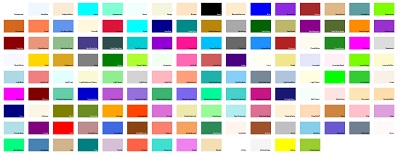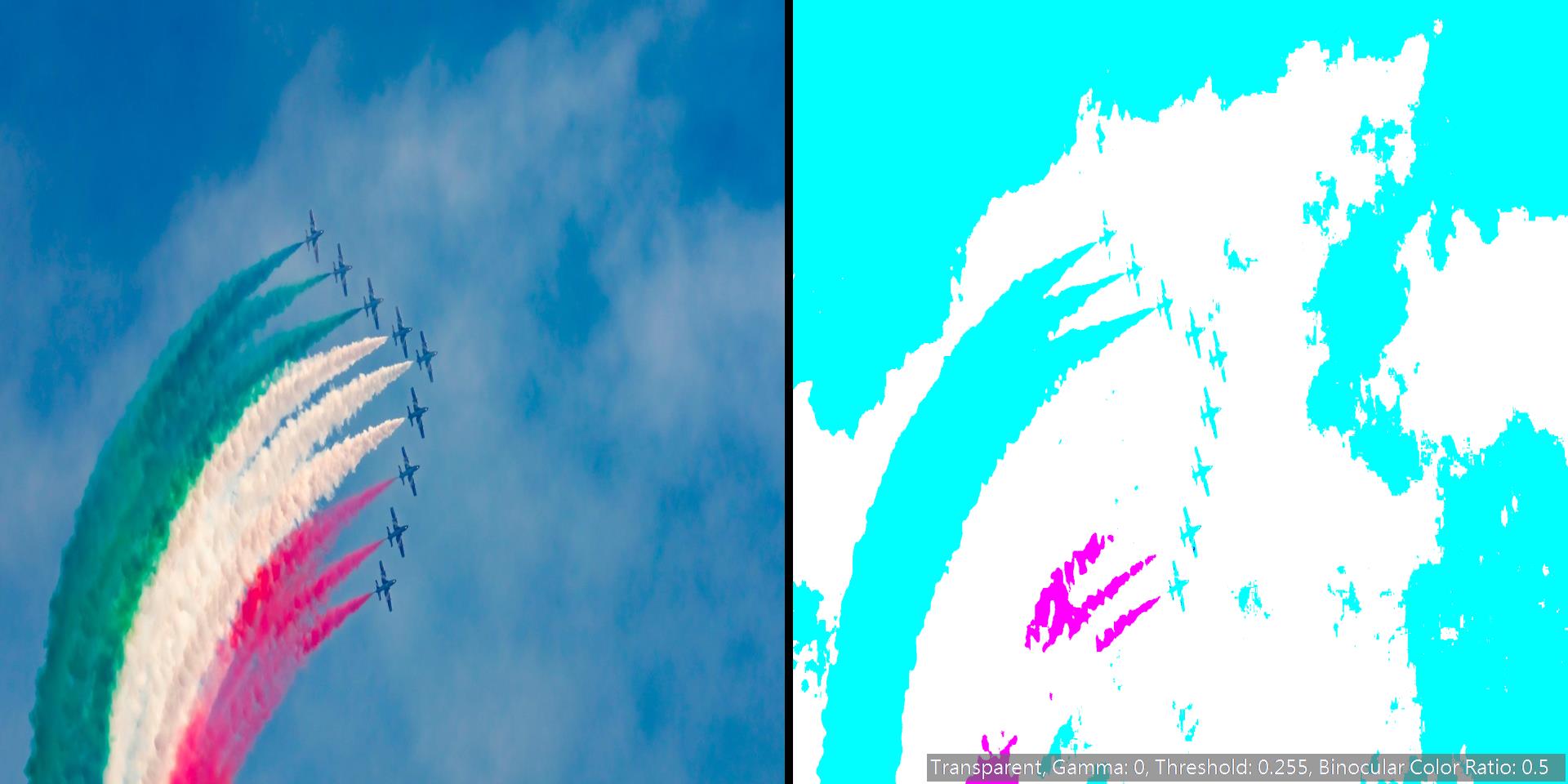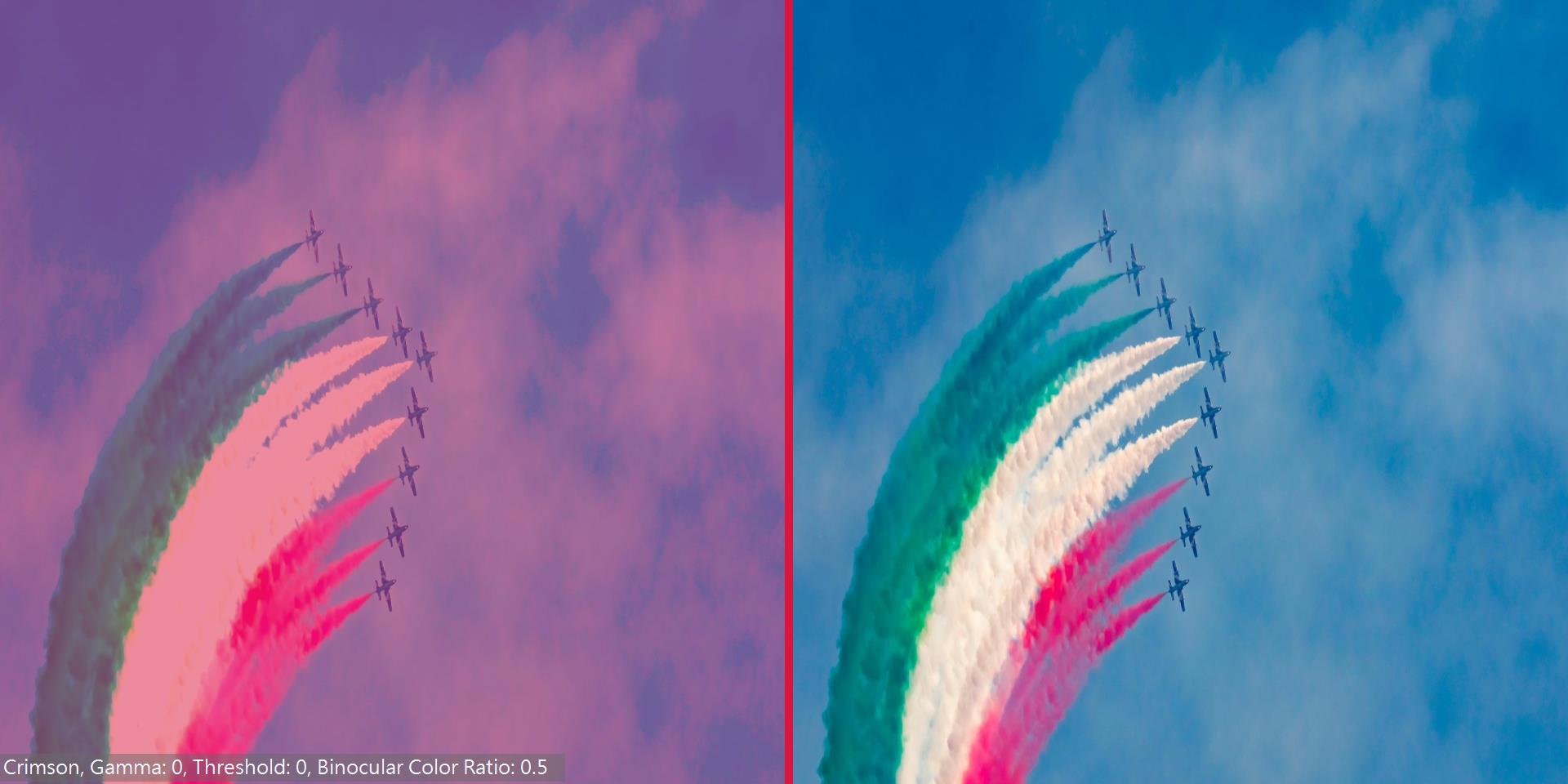Stereoscopic Method For Highlighting The Variation Of Colors
Highlight and identify the variation of an unknown color from known colors for any binocular color combination.
|
* Instructions *
* 1. Take a color picture of an item, area, or scene you believe you question what color you are
seeing or what color it is. This is the unknown target color you want to highlight, identify,
and interpret.
* 2. Choose photo width.
* 3. Choose a known color to target that closely resembles your unknown color.
* 4. Choose Gamma, Threshold, or modify the Binocular color ratio.
* 5. Upload the color picture that contains your unknown target color you want to highlight,
identify, and interpret.
* 6. Choose Eye Preference to test color variation in each eye and to see which eye is dominate.
* 7. Combine.
* 8. Perform a self stereoscopic eye test after upload.
Learn more about our color vision products.
|
|
|
Photo Width:
pixels


|
|
| Choose a known color to target. |
| Choose a known color to target that closely resembles your unknown color. |
| Known Colors: |
|
| Color: |

|
|
— OR —
|
|
Use our color chart or color table to find a color.
|

|
• Binocular color ratio creates a binocular combination of two colors which mixes
them to produce, highlight, or identify the variation of a third color and present
that color, independently, one to each eye.
• Gamma correction is used for contrast enhancement.
• Threshold is used for segmenting objects.
|
Binocular color ratio:
Gamma:
Threshold:
• The contrast ratio must be set to any value above .0, to add gamma or threshold.
• Contrast Ratio min=.0 , max=.255 [.0 no color, .255 for best color results]).
• The larger the ratio value, the stronger the gamma or threshold effect.
|
|
| For best results, use high-resolution images 1920x1080 or larger in .jpg or .png format. |
| Max file size: 5MB. Max file name length: 100. |
| Upload a photo that contains your unknown target color. |
| Crop To Color, No Effect or choose from our Bing™ Wallpaper Archive, |
|
|
| The algorithm will try to highlight and identify your unknown color from known colors if possible. |
| If the color found is not listed as a known color then the color found is a variation of a known color. |
Eye Preference. |
Eye Preference / Ocular Dominance / Dominate Eye:
|
Perform a self stereoscopic eye test after upload. |
• 1. Pick an object from your photo that contains the target color to fixate on.
• 2. Close one eye at a time.
• 3. Cross your eyes halfway between the pictures until both images overlap one another (3 images total),
holding your view on the central image, and with a little patience, the image should 'push' into focus and
you'll know it when you see it!
Another way: To view in stereo, gently cross your eyes so that the two images overlap.
If you're finding this difficult, move away from your monitor or try a smaller image size.
|
Photo notes.
|
• The photo side opposite of known color to target is original photo.
• Photos must be .jpg, or .png, not exceed 5MB, and max width by height is (w)3840px (x) (h)3840px.
• To capture the exact shade of the unknown color from your cellphone or camera. A digital photo taken must be
12 megapixels or greater and be a sharp zoom index of 1.0x or in that range for best results.
|
• Larger width numbers, the larger the photo.
• Width can be any number between 16 and 3840.
• Transparent highlights and identifies colors with no Binocular color combination.
• Colors highlights and identifies colors on the Ocular Dominance side of the photo.
• RGBY (Red-Green & Blue-Yellow) might change existing colors a the pixel level.
• Highlighting or identifying colors is based on high photo pixel bit depth and photo quality.
• Some matched colors may not be highlighted or identified based on pixel bit depth and photo quality.
|
How the algorithm can help your eyesight.
|
• The algorithm can test from picturesque data for visual acuity, color deficiency, contrast sensitivity,
nearsightedness, farsightedness, and blurry vision caused from digital eye strain.
• The algorithm can be used to highlight, identify, and interpret the variation of an unknown color across
an object as it wraps around a curve a user is deficient as seen through the real world in hi-res photos
from a spectrum of known colors using any binocular color combination in one eye or both eyes.
• To make an accurate color identification the algorithm will highlight the variation of the unknown color first
and try to match the color from known colors to identify.
|
|
|
|
|
|
Example 1 Example 2
|


|
Uploading... Please... Wait...3.142.197.212
|
x
Your data is protected by the HIPAA Privacy Rule. |